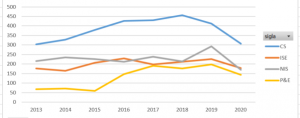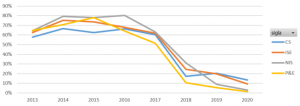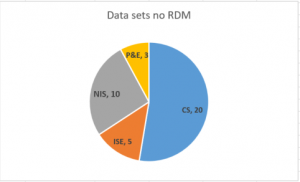The results of research projects must be considered a public asset. This has been the key principle of the Open Access movement; and, after a few years, funding agencies – at European and national levels – have finally welcomed them. The agencies’ claim is quite straightforward: the research outputs developed through public funding must be available to the public. In 2014, FCT approved a ‘Policy on Open Access to Publications arising from FCT-funded Research’, stating unequivocally that “All publications subject to peer review, or other scientific assessment or validation processes, which include results of R&D activities – funded entirely or partially by FCT – must be uploaded by the authors, in their final version, at least to one repository part of the RCAAP network – Portugal Open Access Science Repository, without prejudice to their potential inclusion in other repositories”.
In 2015, a working group within the scope of ERCIM (European Research Consortium for Informatics and Mathematics, with INESC TEC as one of its members), produced the report ‘BOM @ ERCIM – Towards an open access policy for ERCIM’, resorting to the experience of the institutes that comprise ERCIM. Among the main conclusions, the report advocates that the evaluation of researchers’ performance should rely on open access publications, available on a given institutional repository.
In order to facilitate researchers’ compliance with these guidelines, INESC TEC created its Institutional Repository, based on the document management software DSpace. Moreover, INESC TEC integrated it into the RCAAP network and encouraged researchers to use it by uploading their publications, in their final full text version, as pre-print or post-print, i.e. before or after the formatting process by the editor – depending on the publisher’s policies.
Figure 1 shows the evolution of the number of publications registered in Authenticus by the INESC TEC clusters, between 2013 and 2018. Figure 2 shows the percentage of those publications that have the full text available on the Institutional Repository.


The conclusion is obvious. During the first years, namely until the institution’s evaluation in 2017, the percentage of full texts uploaded to the Repository was between 60% and 80%. From then on, there was a drastic reduction of said percentage. Although many of these publications are still available on other open access platforms, this led to a clear undervaluation of INESC TEC’s repository position in RCAAP, also hindering the easy access to INESC TEC’s scientific production.
The BOM Report goes beyond the matter of open access to the final paper, proposing a model of greater transparency in the whole research process, which foresees the publication of versions prior to the final one. This means a certain disconnection between the publication and the peer review processes, and one could assume that the discussion around the reviewing process can be associated with the paper, as complementary material.
Among the resources whose publication is highly recommended, such as laboratory or fieldwork records, the data sets that support the results are particularly significant. The publication of data sets is crucial to ensure the reproducibility of the studies carried out, an aspect that funding agencies and top journals have been increasingly requiring. Moreover, obtaining a good data set is sometimes unrepeatable – for example, in the case of natural phenomena – and, in certain cases, quite costly, depending on the conditions for setting up the experiments, which almost always require a lot of aptitude and effort by the leading researcher. For all these reasons, the data sets, properly organised and described, have been progressively seen as research results themselves, which improve the CV of the respective authors, but also value the papers associated to them, thus drawing the interest by other authors, often leading to quotation.
Acknowledging this fact, FCT published (simultaneously to the Policy on Open Access) a ‘Policy on the Availability of Data and other Results arising from FCT-funded R&D Projects’ which, in a less imperative way, strongly recommends the public availability of data obtained through public funding.
In order to facilitate compliance with these guidelines, INESC TEC established a Research Data Repository, based on the CKAN software, and designed to archive data sets produced or used in different INESC TEC projects. This repository provides different services, namely for the identification of data sets (digital object identifier, or DOI), which facilitates their quotation, the preservation through redundant backups and the visualisation based on Jupyter Notebooks.
In figures 3 and 4, one could observe that all clusters have been depositing data sets on the RDM, despite the uneven amounts, and that there has been a sustained increase in terms of usage, after an initial spike due to the novelty effect.

The Data Repository is also aggregated in the RCAAP, acting as a tool that promotes the FAIR (findable, accessible, interoperable, reusable) principles that govern research data management.

The relevance of data in the research process also led to a demand for the inclusion of data management plans in project proposals, particularly in Europe. The Management Support Service, in charge of the Information Management at INESC TEC, is in a position to support researchers in preparing these plans.
Gabriel David, member of the Executive Board




 News, current topics, curiosities and so much more about INESC TEC and its community!
News, current topics, curiosities and so much more about INESC TEC and its community!